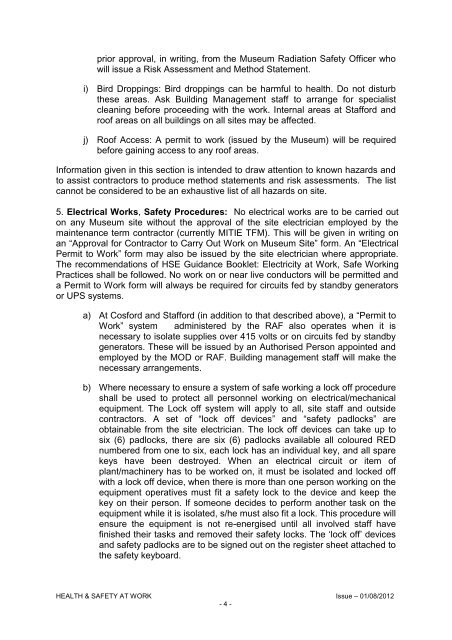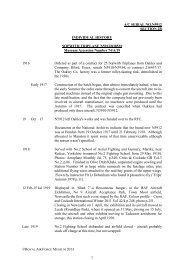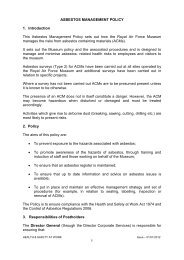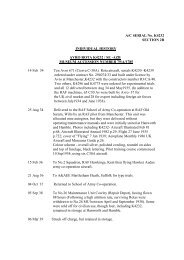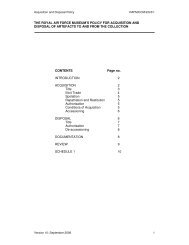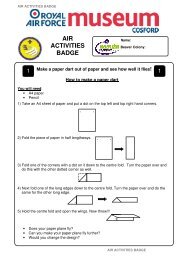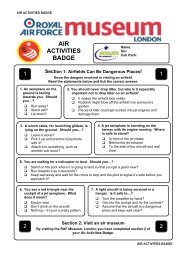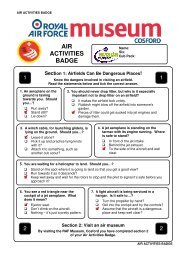Site Instructions and Safety Regulations for Contractors Aug 2012
Site Instructions and Safety Regulations for Contractors Aug 2012
Site Instructions and Safety Regulations for Contractors Aug 2012
You also want an ePaper? Increase the reach of your titles
YUMPU automatically turns print PDFs into web optimized ePapers that Google loves.
prior approval, in writing, from the Museum Radiation <strong>Safety</strong> Officer who<br />
will issue a Risk Assessment <strong>and</strong> Method Statement.<br />
i) Bird Droppings: Bird droppings can be harmful to health. Do not disturb<br />
these areas. Ask Building Management staff to arrange <strong>for</strong> specialist<br />
cleaning be<strong>for</strong>e proceeding with the work. Internal areas at Staf<strong>for</strong>d <strong>and</strong><br />
roof areas on all buildings on all sites may be affected.<br />
j) Roof Access: A permit to work (issued by the Museum) will be required<br />
be<strong>for</strong>e gaining access to any roof areas.<br />
In<strong>for</strong>mation given in this section is intended to draw attention to known hazards <strong>and</strong><br />
to assist contractors to produce method statements <strong>and</strong> risk assessments. The list<br />
cannot be considered to be an exhaustive list of all hazards on site.<br />
5. Electrical Works, <strong>Safety</strong> Procedures: No electrical works are to be carried out<br />
on any Museum site without the approval of the site electrician employed by the<br />
maintenance term contractor (currently MITIE TFM). This will be given in writing on<br />
an “Approval <strong>for</strong> Contractor to Carry Out Work on Museum <strong>Site</strong>” <strong>for</strong>m. An “Electrical<br />
Permit to Work” <strong>for</strong>m may also be issued by the site electrician where appropriate.<br />
The recommendations of HSE Guidance Booklet: Electricity at Work, Safe Working<br />
Practices shall be followed. No work on or near live conductors will be permitted <strong>and</strong><br />
a Permit to Work <strong>for</strong>m will always be required <strong>for</strong> circuits fed by st<strong>and</strong>by generators<br />
or UPS systems.<br />
a) At Cos<strong>for</strong>d <strong>and</strong> Staf<strong>for</strong>d (in addition to that described above), a “Permit to<br />
Work” system administered by the RAF also operates when it is<br />
necessary to isolate supplies over 415 volts or on circuits fed by st<strong>and</strong>by<br />
generators. These will be issued by an Authorised Person appointed <strong>and</strong><br />
employed by the MOD or RAF. Building management staff will make the<br />
necessary arrangements.<br />
b) Where necessary to ensure a system of safe working a lock off procedure<br />
shall be used to protect all personnel working on electrical/mechanical<br />
equipment. The Lock off system will apply to all, site staff <strong>and</strong> outside<br />
contractors. A set of “lock off devices” <strong>and</strong> “safety padlocks” are<br />
obtainable from the site electrician. The lock off devices can take up to<br />
six (6) padlocks, there are six (6) padlocks available all coloured RED<br />
numbered from one to six, each lock has an individual key, <strong>and</strong> all spare<br />
keys have been destroyed. When an electrical circuit or item of<br />
plant/machinery has to be worked on, it must be isolated <strong>and</strong> locked off<br />
with a lock off device, when there is more than one person working on the<br />
equipment operatives must fit a safety lock to the device <strong>and</strong> keep the<br />
key on their person. If someone decides to per<strong>for</strong>m another task on the<br />
equipment while it is isolated, s/he must also fit a lock. This procedure will<br />
ensure the equipment is not re-energised until all involved staff have<br />
finished their tasks <strong>and</strong> removed their safety locks. The ‘lock off’ devices<br />
<strong>and</strong> safety padlocks are to be signed out on the register sheet attached to<br />
the safety keyboard.<br />
HEALTH & SAFETY AT WORK Issue – 01/08/<strong>2012</strong><br />
- 4 -


